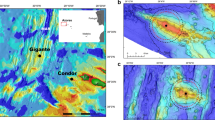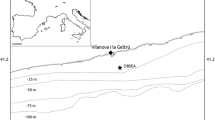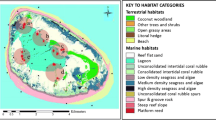Abstract
A number of local populations of finless porpoises (Neophocaena phocaenoides) are widely distributed throughout the warm coastal waters of Asia. The Omura Bay population, consisting of approximately 300 individuals, is the smallest of five populations inhabiting Japanese waters. It is a relatively new population that established after the global warming that took place approximately 9000 years ago. To observe whether these porpoises appear in the major corridor to the ocean from Omura Bay, we used acoustic monitoring to record occurrences of finless porpoises from November 2007 to May 2009. A stereo acoustic event recorder recorded the intensity and the sound source direction of biosonar signals, providing independent traces of sound sources corresponding to each detected animal. A total of 226 individuals were detected over the 1.5-year monitoring period, of which 76% occurred at night and 73% occurred during March and April. We compared the presence of porpoises to the Japanese anchovy catch in Omura Bay and the Hario Strait over the same period. Results suggested that possible reductions in anchovy resources in the bay could attract porpoises to the outside of their normal habitat. In total, 70% of the porpoise recordings took place when the tidal current was moving out of Omura Bay. Porpoises might follow the prey that are transported out of the bay due to the strong outbound current. The finless porpoises confined to the bay might extend their swimming area if prey is available.







Similar content being viewed by others
References
Akamatsu T, Wang D, Wang K, Wei Z, Zhao Q, Naito Y (2002) Diving behavior of freshwater finless porpoises (Neophocaena phocaenoides) in an oxbow of the Yangtze River. China. ICES J Marine Sci 59:483–443
Akamatsu T, Wang D, Wang K (2005) Off-axis sonar beam pattern of free-ranging finless porpoises measured by a stereo pulse event data logger. J Acoust Soc Am 117:3325–3330
Akamatsu T, Teilmann J, Miller LA, Tougaard J, Dietz R, Wang D, Wang K, Siebert U, Naito Y (2007) Comparison of echolocation behaviour between coastal and riverine porpoises. Deep-Sea Research II 54:290–297
Akamatsu T, Wang D, Wang K, Li S, Dong S (2010) Scanning sonar of rolling porpoises during prey capture dives. J Exp Biol 213:146–152
Aoki I, Tsuruta Y (1989) Observations on the Recatchive Behaviour of Japanese Anchovy Engrauiis japonica in captivity. Nippon Suisan Gakkaishi 55:255–259
Au WWL, Kastelein RA, Rippe T, Schooneman NM (1999) Transmission beam pattern and echolocation signals of a harbor porpoise, Phocoena phocoena. J Acoust Soc Am 106:3699–3705
Azeta M (1981) Some consideration on the high mortality during the larval stage of fish with special reference to the fluctuation of population–based on the population dynamics investigations of early life history of anchovy-. Gyogyou Shigen Kenkyukaigi Houkoku 22:7–28
Fisheries Agency of Japan and Fisheries Research Agency (2008) Finless Porpoise, Neophocaena phocaenoides in Japanese waters. The Current Status of International Fishery Stocks in 2008. 53:1–5
Jefferson TA (2002) Preliminary analysis of geographic variation in cranial morphometrics of the finless porpoise (Neophocaena phocaenoides). Raffles Bull Zool Supplement 10:3–14
Kamminga C (1988) Echolocation signal type of odontocetes. In: Nachtigall PE, Moore PWB (eds) Animal sonar: processes and performance. Plenum Press, New York, pp 9–22
Kimura S, Akamatsu T, Wang K, Wang D, Li S, Dong S, Arai N (2009) Comparison of stationary acoustic monitoring and visual observation of finless porpoises (Neophocaena phocaenoides). J Acoust Soc Am 125:47–553
Koschinski S, Culik BM, Damsgaard Henriksen O, Tregenza N, Ellis G, Jansen C, Kathe G (2003) Behavioural reactions of free-ranging porpoises and seals to the noise of a simu- lated 2 MW windpower generator. Mar Ecol Prog Ser 265:263–273
Li S, Wang D, Wang K, Akamatsu T (2006) Sonar gain control in echolocating finless porpoises (Neophocaena phocaenoides) in an open water. J Acoust Soc Am 120:1803–1806
Matsuoka K (2005) Omura-wan, Nagasaki Shimbun Shinsho 013, pp 189
Matuoka M, Miyaji K, Nakamura Y, Wu R, Liu H (1998) Spawning time and egg development of the Japanese sardine and Japanese anchovy determined by the serial net samplings off southern Kyushu, Japan. Bull Seikai National Fisheries Res Institute 76:1–10
Reeves RR (2007) Dolphins, whales and porpoises, IUCN/SSC Cetacean Specialist Group, 2002–2010 conservation action plan for the world’s cetaceans, compiled by Smith BD, Crespo EA, di Sciara GN
Shirakihara K, Yoshida H, Shirakihara M, Takemura A (1992) A questionnaire survey on the distribution of the finless porpoise, (Neophocaena phocaenoides), in Japanese waters. Marine Mammal Sci 8:160–164
Shirakihara M, Shirakihara K, Takemura A (1994) Distribution and seasonal density of the finless porpoise Neophocaena phocaenoides in the coastal waters of western Kyushu, Japan. Fisheries Sci 60:41–46
Shirakihara K, Shirakihara M, Yamamoto Y (2007) Distribution and abundance of finless porpoise in the Inland Sea of Japan. Mar Biol 150:1025–1032
Shirakihara M, Seki K, Takemura A, Shirakihara K, Yoshida H, Yamazaki T (2008) Food habits of finless porpoises Neophocaena phocaenoides in Western Kyushu, Japan. J Mammal 89:1248–1256
Tsuruta Y (1992) Recatchion in the Japanese anchovy (Engraulis japonica) as related to population fluctuation. Bull National Res Institute Fisheries Eng 13:129–168
University Nagasaki (1976) Report of water pollution and countermeasures in the Omura Bay. Faculty of Fisheries, Nagasaki University, Nagasaki, p 113
Yoshida H, Shirakihara K, Kishino H, Shirakihara M, Takemura A (1998) Finless porpoise abundance in Omura Bay, Japan: Estimation from aerial sighting surveys. J Wildl Manage 6:286–291
Yoshida H, Yoshioka M, Shirakihara M, Chow S (2001) Population structure of finless porpoises (Neophocaena phocaenoides) in coastal waters of Japan based on mitochondrial DNA sequences. J Mammal 82:123–130
Yoshida H, Shirakihara M, Takemura A, Shirakihara K (2002) Population structure of finless porpoises (Neophocaena phocaenoides) in coastal waters of Japan. Raffles Bull Zool, Supplement 10:35–42
Zheng JS, Xia JH, He SP, Wang D (2005) Population genetic structure of the yangtze finless porpoise (Neophocaena phocaenoides asiaeorientalis): implications for management and conservation. Biochem Genet 43:307–320
Acknowledgments
We thank Fumio Hamaguchi (Hamaguchi Marine Service) for the deployment of the monitoring system. Takeshita Suisan Co. Ltd., Segawa Fisheries Cooperative Association, Sasebo City Fisheries Cooperative provided the data of fisheries statistics and shared their various knowledge of fisheries in the study site with us. Professor Hideaki Nakata, Mr. Hirokazu Suzaki and the members of Nakata Laboratory at Nagasaki University kindly allowed using long-term water temperature data of the study site. Natural Environmental Division of Nagasaki Prefectural Government supported our project. We specially thank Kunio Shirakihara, Miki Shirakihara, Hideyoshi Yoshida for their valuable comments on this manuscript. This research was supported by Grant-in-Aid for Scientific Research (B) 19405005, Research and Development Program for New Bio-industry Initiatives and Resource conservation of Eastern Asia Estuary.
Author information
Authors and Affiliations
Corresponding author
Additional information
Communicated by S. Garthe.
Rights and permissions
About this article
Cite this article
Akamatsu, T., Nakamura, K., Kawabe, R. et al. Seasonal and diurnal presence of finless porpoises at a corridor to the ocean from their habitat. Mar Biol 157, 1879–1887 (2010). https://doi.org/10.1007/s00227-010-1459-8
Received:
Accepted:
Published:
Issue Date:
DOI: https://doi.org/10.1007/s00227-010-1459-8




